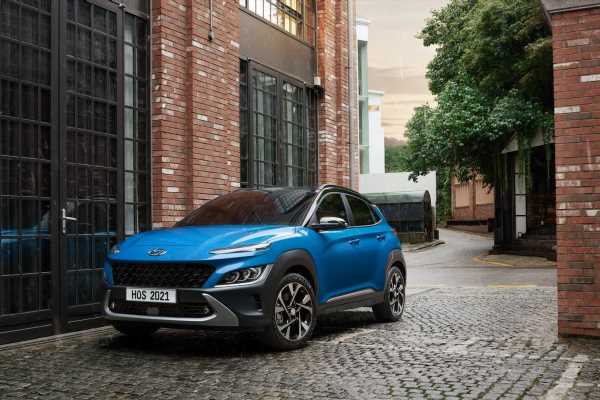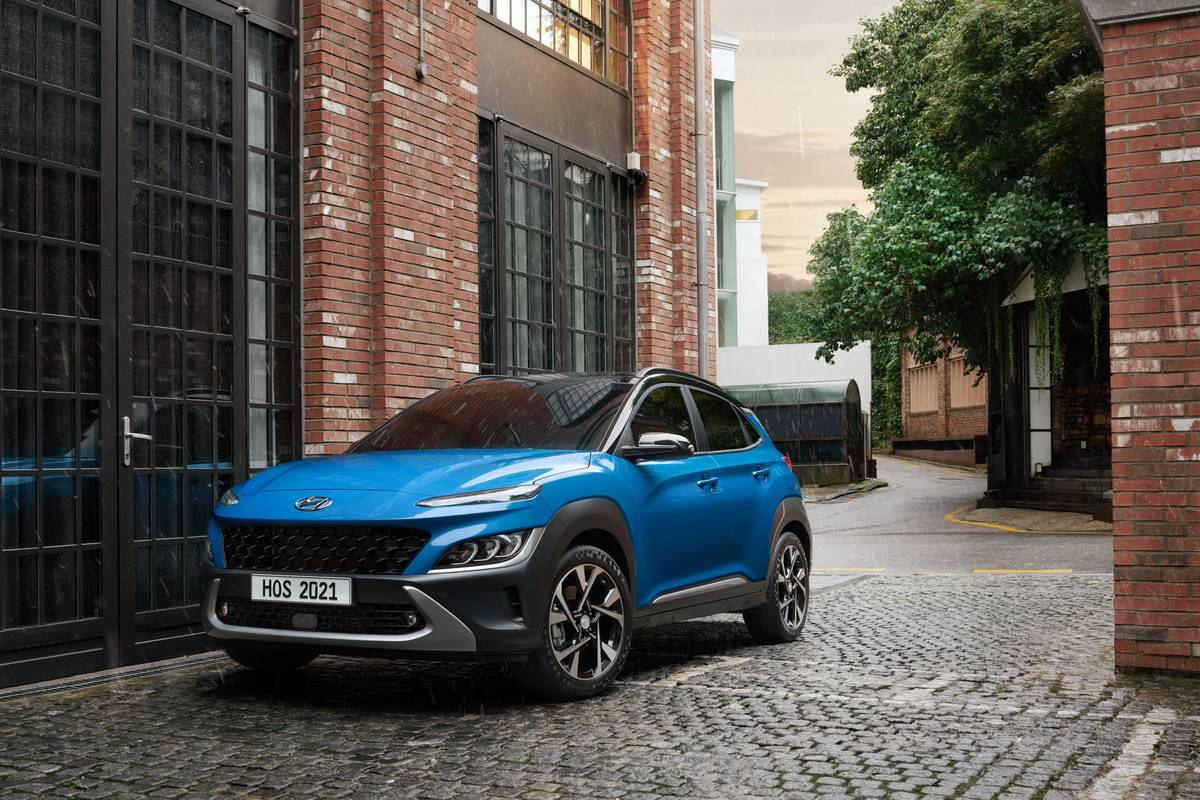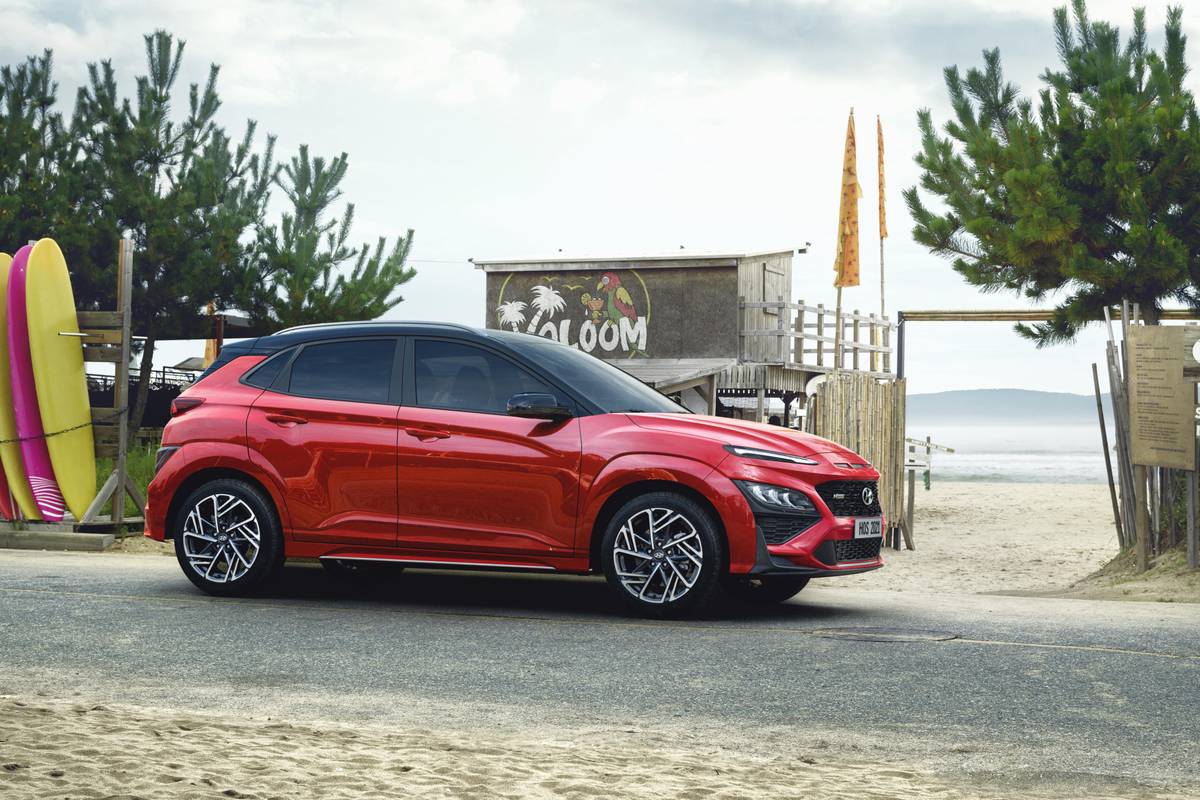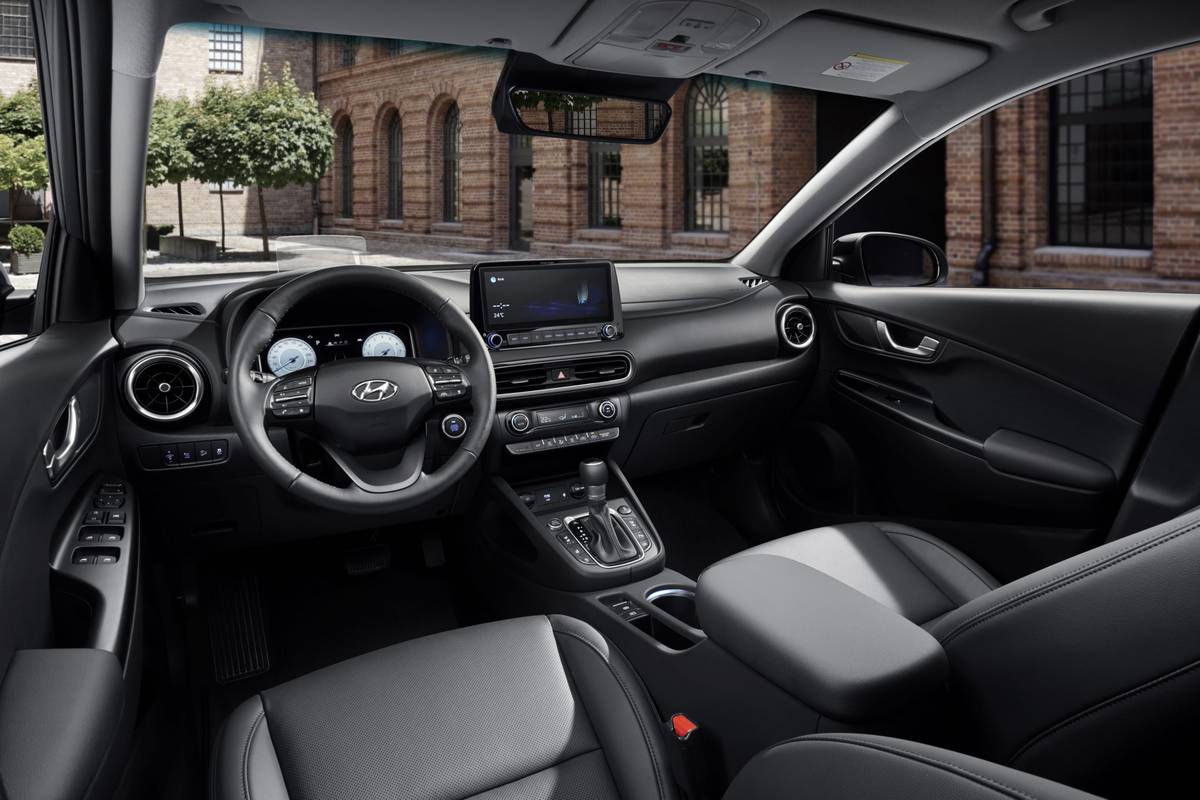Competes with: Chevrolet Trailblazer, Ford EcoSport, Honda HR-V, Kia Seltos, Mazda CX-30, Subaru Crosstrek
Looks like: Mild styling tweaks to the 2018-21 Kona, with a lot less cladding if you get the N Line
Powertrain: Unclear, but likely a 2.0-liter four-cylinder with six-speed automatic transmission or turbocharged 1.6-liter four-cylinder with seven-speed dual-clutch automatic; front- or all-wheel drive
Hits dealerships: Likely early 2021
Hyundai announced a raft of changes to its pint-sized Kona SUV, including revised styling, mechanical updates, larger information displays and new driver-assistance technologies. The refreshed SUV goes on sale internationally near the end of 2020, and Hyundai tells us we’ll know more details for the U.S. model around then.
Related: Next Hyundai Kona Is Also Next in Line for N Line
There’s also a new, sporty variant called the N Line, which falls in line with other Hyundai models that carry the treatment, such as the redesigned Elantra sedan and just-discontinued Elantra GT. (As its name suggests, N Line is a performance-light version of Hyundai’s standalone N designation — as in, the Veloster N — which signals the brand’s highest performance envelope.)
Unfortunately, we don’t know which updates the refreshed Kona — designated a 2022 model — will get when it comes stateside. Details for the U.S. version “will come closer to the end of the year,” said Derek Joyce, a spokesperson for the South Korean automaker’s U.S. arm. “But the U.S. model will be a 2022 [model year], yes.”
Given Hyundai’s international timing, we’d expect the 2022 Kona to hit U.S. dealerships sometime in early 2021. As a harbinger of the Kona to come, we’ve put together a rundown of global changes for the nameplate.
Exterior
The N Line gains more visual differentiation than Kona trims of yore. If you didn’t like the SUV’s ubiquitous gray cladding — it covers the fenders, bumpers, lower doors and side sills — the N Line trades almost all of them for body-colored panels. It also gets reshaped bumper openings up front, with fin-shaped ground effects and taller cladding below the headlights (presuming those still sit, as before, at mid-level). Those lights fan out a bit more now, with a new trio of C-shaped bezels on each side. The tail, meanwhile, gets reshaped lower reflectors. As before, a black roof is available regardless of exterior color to give the Kona a two-tone look.
Wheels range from 16 to 18 inches, and overall length has increased slightly with the refresh. The updated Kona is about 1.6 inches longer than before, Hyundai says.
Interior
Changes inside include a rejiggered center console with more storage courtesy of an electronic parking brake in place of the outgoing handbrake, plus more visual separation from the dashboard. Above it, Hyundai replaces the outgoing dash display — a standard 7-inch or optional 8-inch screen — with 8- or 10.25-inch screens. Both have Apple CarPlay and Android Auto, as was the case before, but the 8-incher gets wireless integration of both smartphone integrations. It’s unclear if the 10.25-inch display reverts to tethered connections, one of several caveats with the 10.25-inch display for the new Kia K5. (Affiliated automakers Hyundai and Kia often share the same touchscreens; Joyce said to “stay tuned” on wireless versus wired integration for the larger display.) A 10.25-inch virtual gauge cluster is also available in the refreshed Kona, but it wasn’t immediately clear if it’s standard or optional. Given the SUV’s history of affordable pricing, we expect the latter.
Hyundai notes additional cargo space and backseat legroom — both weaknesses that cost the current-generation Kona points in our comparison against other subcompact SUVs in 2018. The exact degree of increase wasn’t clear, however. Seats come in cloth or leather, with automatic climate control, heated and ventilated front seats, and a heated steering wheel among the amenities in the model Hyundai showed. Heated rear seats are new, the automaker says.
Related Video:
Engine and Transmission
The Kona’s turbocharged 1.6-liter engine makes 198 metric horsepower — equivalent to 195 SAE horsepower here in the U.S., though market-specific outputs have yet to be released. If the translation holds, it would represent a decent bump from the Kona’s current 175 hp. The engine, an option on the 2018-21 Kona, also makes 195 pounds-feet of torque, but Hyundai didn’t mention any changes on that front. It also didn’t say anything about the Kona’s base engine in the U.S., a non-turbo 2.0-liter four-cylinder (147 hp, 132 pounds-feet of torque). That engine pairs with a six-speed automatic transmission; the turbo 1.6-liter gets a seven-speed dual-clutch automatic.
All-wheel drive is available. Hyundai will also offer a 1.6-liter diesel engine or 1.0-liter gasoline engine, both available with 48-volt mild-hybrid technology, in global markets for the Kona. Neither engine appeared in the 2018-21 Kona stateside, nor did the Kona Hybrid, a car introduced earlier overseas but not here. It combines a 1.6-liter engine with a 32-kilowatt electric motor, but Joyce did not say if the hybrid or other powertrains would come stateside for 2022.
Hyundai touts changes to suspension tuning aimed to make the Kona “more comfortable to drive” — a much-needed update over the current generation’s choppy ride — with retuned steering and additional noise insulation; N Line models have separate steering tuning. That said, automakers often tune minor components to fit consumer tastes in different global regions, so we’ll have to wait to hear if such revisions make it to the U.S. model.
The updated Kona Electric, which carries over the powertrain and driving range of its predecessor, “will be revealed soon,” Hyundai says. The automaker sells the current Kona Electric, which has a none-too-shabby 258 miles of EPA range, in only 10 states, all of which impose minimum sales quotas for zero-emission vehicles. That strategy remains the plan “for the near future,” Joyce said.
More From Cars.com:
- Here Are the 10 Cheapest New SUVs You Can Buy Right Now
- 2020 Hyundai Kona Gets Small Price Bump, Adaptive Cruise Control in Top Trim
- How Do Car Seats Fit in a 2020 Hyundai Kona?
- What’s the Best Subcompact SUV for 2018?
- Research the 2021 Hyundai Kona
Safety and Driver-Assistance Features
Available features include adaptive cruise control, now with stop-and-go functionality, plus an alert for when the car ahead starts moving. The Kona’s blind spot warning and rear cross-traffic alert systems gain braking intervention if you try to change lanes or back up, respectively, while either system detects potential danger. Lane Following Assist, Hyundai’s terminology for lane-centering steering, is also new. The Kona’s automatic emergency braking system, a standard feature for 2021 that included pedestrian detection on top trim levels, adds optional cyclist detection for 2022. The Kona will also offer alerts to check the backseat after you’ve parked and avoid opening doors if sensors detect oncoming traffic.
Again, features specific to the U.S. market remain pending.
Cars.com’s Editorial department is your source for automotive news and reviews. In line with Cars.com’s long-standing ethics policy, editors and reviewers don’t accept gifts or free trips from automakers. The Editorial department is independent of Cars.com’s advertising, sales and sponsored content departments.
Source: Read Full Article




